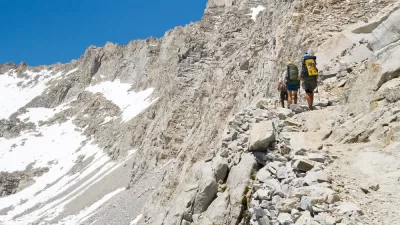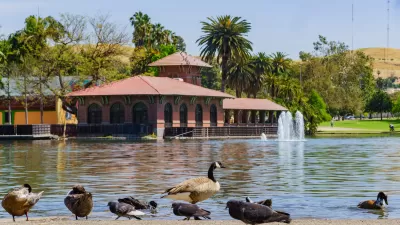This piece from Places delves into the history of the campsite, their use of space, and their role in modern culture.
"This summer millions of Americans will take to the road in search of this powerful experience of nature. And that parcel of land upon which most will elect to drive their car, set up their tent, park their trailer or RV is the campsite - which is thus not only an imagined ideal but also the fundamental unit of management of the modern campground. There are 113,000 federally managed campsites in the United States, 166,000 campsites dispersed across state parks, and untold numbers in private facilities. [3] Last year Kampgrounds of America - KOA, familiarly - alone reported a total usage of over five million campsite nights, as well as 1.5 million hits monthly on its website. [4]
Modern campsites embody a peculiar contradiction: They are defined and serviced by an increasingly sophisticated range of utilities and conveniences, and yet marketed to perpetuate the cherished American ideal of the backwoods camp. For artist Robert Smithson, whose sensitivities to site and site-making were informed by childhood family camping trips he helped organize, the campsite was where one could reenact the making of a place. [5] Campgrounds indeed commodify into multiple sites - literally tens of thousands of them - with each functioning as the locus of a singular experience, which is itself further commodified and mediated by popular imagery. The record sales reported by sporting utility stores like REI and EMS owe largely to the retailers' successful efforts to associate their equipment with the out-of-doors and the prospect of healthy living. For many urbanites, high-performance gear - hiking boots, mountaineering vests, etc. - have become staples of everyday casual chic."
Author Martin Hogue is a fellow at the College of Environmental Forestry at the State University of New York, Syracuse.
FULL STORY: A Short History of the Campsite

Planetizen Federal Action Tracker
A weekly monitor of how Trump’s orders and actions are impacting planners and planning in America.

Restaurant Patios Were a Pandemic Win — Why Were They so Hard to Keep?
Social distancing requirements and changes in travel patterns prompted cities to pilot new uses for street and sidewalk space. Then it got complicated.

Map: Where Senate Republicans Want to Sell Your Public Lands
For public land advocates, the Senate Republicans’ proposal to sell millions of acres of public land in the West is “the biggest fight of their careers.”

Maui's Vacation Rental Debate Turns Ugly
Verbal attacks, misinformation campaigns and fistfights plague a high-stakes debate to convert thousands of vacation rentals into long-term housing.

San Francisco Suspends Traffic Calming Amidst Record Deaths
Citing “a challenging fiscal landscape,” the city will cease the program on the heels of 42 traffic deaths, including 24 pedestrians.

California Homeless Arrests, Citations Spike After Ruling
An investigation reveals that anti-homeless actions increased up to 500% after Grants Pass v. Johnson — even in cities claiming no policy change.
Urban Design for Planners 1: Software Tools
This six-course series explores essential urban design concepts using open source software and equips planners with the tools they need to participate fully in the urban design process.
Planning for Universal Design
Learn the tools for implementing Universal Design in planning regulations.
Heyer Gruel & Associates PA
JM Goldson LLC
Custer County Colorado
City of Camden Redevelopment Agency
City of Astoria
Transportation Research & Education Center (TREC) at Portland State University
Camden Redevelopment Agency
City of Claremont
Municipality of Princeton (NJ)





























